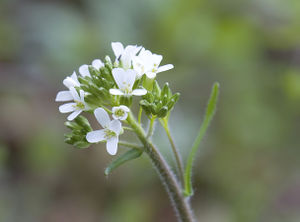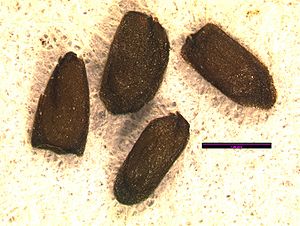Arabis eschscholtziana
- Scientific Name: Arabis eschscholtziana
- Family: Brassicaceae
- Common Names: hairy rockcress, Pacific coast rockcress
- Synonyms/Misapplications: Arabis hirsuta var. eschscholtziana, Arabis hirsuta var. glabrata
- Codon: ARAHIR
Contents
Taxonomy
| Scientific classification | |
|---|---|
| Kingdom: | Plantae |
| Subkingdom: | Virviriplantae |
| Phylum: | Tracheophyta |
| Subphylum: | Spermatophytina |
| Class: | Magnoliopsida |
| Subclass: | Rosanae |
| Order: | Brassicales |
| Family: | Brassicaceae |
| Genus: | Arabis L. |
| Species: | Arabis escholtziana Andrz. |
| Synonyms | |
| |
Description
Biennial or perennial herb with white flowers[2] growing from a taproot, up to 10 dm tall.[3] Plants hirsute basally, become glabrous above, stems often branched.[2] Leaves mostly cauline, alternate, auriculate-clasping,[4] lower surface purple pubescent, glabrous above.[3] Inflorescences racemose, simple or branched[2], ebractate.[4] Sepals 4, glabrous,[3] lateral pair saccate basally;[4] petals 4; stamens 6, tetradynamous; style to 1 mm.[3] Siliques erect to appressed, 3-6 cm long.[4]
Bloom Period
April to July[3]
Distribution
Covering much of western North America, in Washington more common east of the Cascade crest.[3]
Habitat
Moist to dry, usually calcareous, open situations: open woods, stream banks, ledges, cliffs, bluffs, and floodplains. It occurs frequently in disturbed habitats. Dunes and dry banks, rocky/chalk, limestone slopes and gravelly native prairie. Plants seem to be more abundant where grazing is light.[5]
Propagation
Sow the seed as soon as it is ripe in a light position in a cold frame. Seed can also be sown in spring. When large enough to handle, prick the seedlings out into individual pots and plant them out in the summer. Conduct divisions after flowering, usually in the spring. The divisions can be planted into their permanent plots if required. [6]
Seed
Seed sample from: 2011
Average Measurement: 1.6 x 0.9 x 0.2
Measurement Range: L: 1.3 - 1.75, W: 0.6 - 1, D: 0.1 - 0.3
Features
Shape: Seeds flat, somewhat winged, especially at hilum end and opposite. Accumbent cotyledons and sulcus present.
Color: Seed dark brown in center, darkening to black at the winged edges. Hilum inconspicuous.
Surface: Texture is bumpy, and seed is somewhat lustrous.
Latitudinal Cross Section: elliptical ![]()
Longitudinal Cross Section: elliptical ![]()
Basic Explanations and Assumptions:
The dimensions for the seeds are length x width x depth. The location of the hilum is used as the base of the seed, and the length is measured from hilum to the opposite apex. Where a style is present, the length is measured from the hilum to the bottom of the style. Width is measured at a right angle to the length at the widest part. Depth is measured at a right angle to the intersection of height and width lines.
Measurements included are the mean average for each measurement of ten separate seeds.
All measurements in millimeters unless otherwise noted.
Photo Gallery
References
- ↑ Integrated Taxonomic Information System. Retrieved from https://www.itis.gov/servlet/SingleRpt/SingleRpt?search_topic=TSN&search_value=508988
- ↑ 2.0 2.1 2.2 Flora of North America. Retrieved from http://dev.floranorthamerica.org/Arabis_eschscholtziana
- ↑ 3.0 3.1 3.2 3.3 3.4 3.5 WTU Herbarium, Burke Museum, & University of Washington. Retrieved from http://biology.burke.washington.edu/herbarium/imagecollection/taxon.php?Taxon=Arabis%20eschscholtziana
- ↑ 4.0 4.1 4.2 4.3 Hitchcock, C. L., Cronquist, A., Giblin, D., & Legler, B. et al. (2018). Flora of the Pacific Northwest: an illustrated manual. Seattle: University of Washington Press. p. 283.
- ↑ University of Washington. Retrieved from https://depts.washington.edu/propplnt/Plants/Arabis.htm.
- ↑ Rice, G. (1988). A Wide Range of Perennial Plants that can be Grown in Britian and How to Grow Them. Volume 2. Thompson and Morgan.



